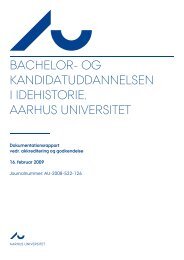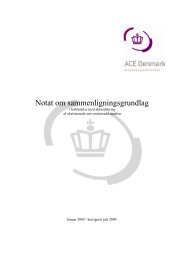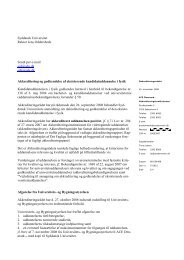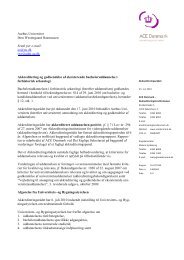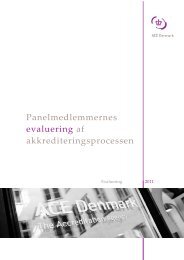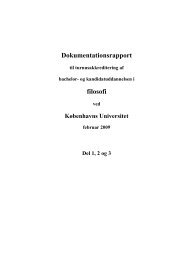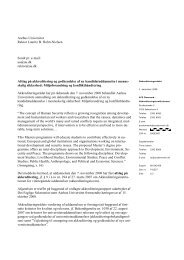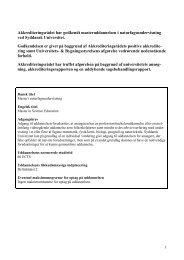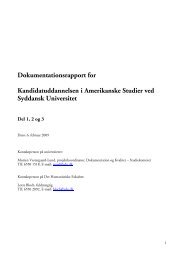Studieordning for Filosofi og Videnskabsteori - ACE Denmark
Studieordning for Filosofi og Videnskabsteori - ACE Denmark
Studieordning for Filosofi og Videnskabsteori - ACE Denmark
You also want an ePaper? Increase the reach of your titles
YUMPU automatically turns print PDFs into web optimized ePapers that Google loves.
“What did the abbacus teachers aim at when they (sometimes) ended up doing mathematics? An investigation of the<br />
incentives and norms of a distinct mathematical practice”. Forthcoming in the proceedings of the conference<br />
“Perspectives on Mathematical Practices”, 26–28 March<br />
2007, Vrije Universiteit Brussel.<br />
“Les lais: or, What Ever Became of Mesopotamian<br />
Mathematics?”, pp. 99–119 in Micah Ross (ed.), From the Banks of the<br />
Euphrates. Studies in Honor of Alice Louise Slotsky. Winona Lake,Indiana: Eisenbrauns, 2007<br />
“Generosity: No Doubt, but at Times Excessive<br />
and Delusive”. Journal of Indian Philosophy 35 (2007), 469–485<br />
“The `Unknown Heritage': Trace of a Forgotten Locus of Mathematical<br />
Sophistication”. Archive <strong>for</strong> History of Exact<br />
Sciences online, DOI 10.1007/s00407-008-0025-y.<br />
“The Roles of Mesopotamian<br />
Bronce Age Mathematics: Tool <strong>for</strong> State Formation and Administration – Carrier of Teachers'<br />
Professional Intellectual Autonomy”. Educational Studies in Mathematics 66 (2007), 257–271. doi: 10.1007/s10649-<br />
007-9090-4.<br />
“Bronze Age Formal Science?”, pp. 81–102 in Benedikt Löwe,<br />
Volker Peckhaus & Thoralf Räsch (eds), 2006. Foundations<br />
of the Formal Sciences IV. The History of the Concept of the Formal Sciences. (Studies in L<strong>og</strong>ic, 3). London:<br />
College Publications.<br />
“Artificial<br />
Language in Ancient Mesopotamia – a Dubious and a Less Dubious Case”. Journal of Indian Philosophy 34<br />
(2006), 57–88.<br />
“Jacopo da Firenze and the Beginning of Italian Vernacular Algebra”. Historia Mathematica 33 (2006), 4–42. DOI:<br />
10.1016/j.hm.2005.03.001.<br />
“Leonardo Fibonacci and Abbaco Culture: a Proposal to Invert the Roles”. Revue d'Histoire<br />
des Mathématiques 11 (2005),<br />
23–56.<br />
eptual Divergence – Canons and Taboos – and Critique: Reflections on Explanatory Categories”. Historia Mathematica<br />
004), 129–147.<br />
etrical Problems: Traces of Unknown Links between Jaina and Mediterranean Mathematics in the Classical<br />
Sciences. New Delhi:<br />
Dold-Samplonius<br />
aris: 2000 Years Transmission of Mathematical Ideas. (Boethius, 46). Stuttgart: Steiner,<br />
2002.<br />
. 121–145 in<br />
stronomy and Mathematics in the Ancient Near East.<br />
ing to Aristotle, Euclid,<br />
ence in Context 14<br />
, 85–131.<br />
thematical Corpus. Elements of Classification, with some Results”, pp. 117–<br />
achim Oelsner<br />
burtstages am 18. Februar 1997. (Altes Orient und Altes Testament, 252). Münster: Ugarit<br />
k Area. Prospecting the Borderland Between Decoration, Art, and Structural<br />
, 2000. “Jacobus de Florentia, Tractatus algorismi (1307), the chapter on algebra (Vat. Lat. 4826, fols 36 v –45 v “Conc<br />
31 (2<br />
“Mahāvīra's Geom<br />
Ages”, pp. 83–95 in Ivor Grattan-Guinness & B. S. Yadav (eds), History of the Mathematical<br />
Hindustan Book Agency.<br />
“Seleucid Innovations in the Babylonian `Algebraic' Tradition and Their Kin Abroad”, pp. 9–29 in Yvonne<br />
et al (eds), From China to P<br />
“How to Educate a Kapo, or, Reflections on the Absence of a Culture of Mathematical Problems in Ur III”, pp<br />
John M. Steele & Annette Imhausen (eds), Under One Sky. A<br />
(Alter Orient und Altes Testament, 297). Münster: Ugarit-Verlag, 2002.<br />
“Existence, Substantiality, and Counterfactuality. Observations on the Status of Mathematics Accord<br />
and Others”. Centaurus 44 (2002), 1–31.<br />
“On a Collection of Geometrical Riddles and Their Role in the Shaping of Four to Six `Algebras'”. Sci<br />
(2001)<br />
“The Finer Structure of the Old Babylonian Ma<br />
177 in Joachim Marzahn & Hans Neumann (eds), Assyriol<strong>og</strong>ica et Semitica. Festschrift für Jo<br />
anläßlich seines 65. Ge<br />
Verlag, 2000.<br />
“Geometrical Patterns in the Pre-classical Gree<br />
Inquiry”. Revue d'Histoire des Mathématiques 6 (2000), 5–58.<br />
(ed., trans.)<br />
)”.<br />
Centaurus 42 (2000), 21–69.<br />
“A New Art in Ancient Clothes. Itineraries Chosen between Scholasticism and Baroque in Order to Make Algebra Appear<br />
Legitimate, and Their Impact on the Substance of the Discipline”. Physis, n.s. 35 (1998),<br />
11–50.<br />
“`Ox<strong>for</strong>d' and `Gherardo da Cremona': on the Relation between Two Versions of al-Khwārizmī's Algebra”,<br />
pp. 159–178 in<br />
Actes du 3 tiques Arabes, Tipaza (Alger, Algérie), 1–3 Décembre<br />
atiques, 1998.<br />
relacionados con<br />
ection of `Algebraic' and Related Problems<br />
with Concise Analysis”. Mathesis 13:3 (Mexico, 1997), 224–353.<br />
me inesistente?” Analecta Romana Instituti Danici 25 (1997), 141–172.<br />
nd Near Eastern Practical Geometry. An Investigation of Metrica, Geometrica, and other Treatises”, pp.<br />
d ihre Rezeption,<br />
ry of Science 34 (1996),<br />
n Problem»”. AIΩN.<br />
Studi del Mondo Classico e del Mediterraneo Antico. Sezione linguistica. Istituto<br />
me Colloque Maghrébin sur l'Histoire des Mathéma<br />
1990, vol. II. Alger: Association Algérienne d'Histoire des Mathém<br />
“Textos de procedimientos matemáticos de la antigua Babilonia. Una selección de problemas `algebraicos' y<br />
un analisi conciso / Old Babylonian Mathematical Procedure Texts. A Sel<br />
“Reflections on the Baroque in the History of Science”. Physis 24 (1997), 675–694.<br />
“Barocco e scienza secentesca: un lega<br />
“Hero, Ps.-Hero, a<br />
67–93 in Klaus Döring, Bernhard Herzhoff & Georg Wöhrle (eds), Antike Naturwissenschaft un<br />
Band 7. Trier: Wissenschaftlicher Verlag Trier, 1997.<br />
“Changing Trends in the Histori<strong>og</strong>raphy of Mesopotamian Mathematics: An Insider's View”. Histo<br />
1–32.<br />
“Sumerian: The Descendant of a Proto-Historical Creole? An Alternative Approach to the «Sumeria<br />
Annali del Dipartimento di<br />
Universitario Orientale, Napoli 14 (1992; publ. 1994), 21–72, Figs. 1–3.




